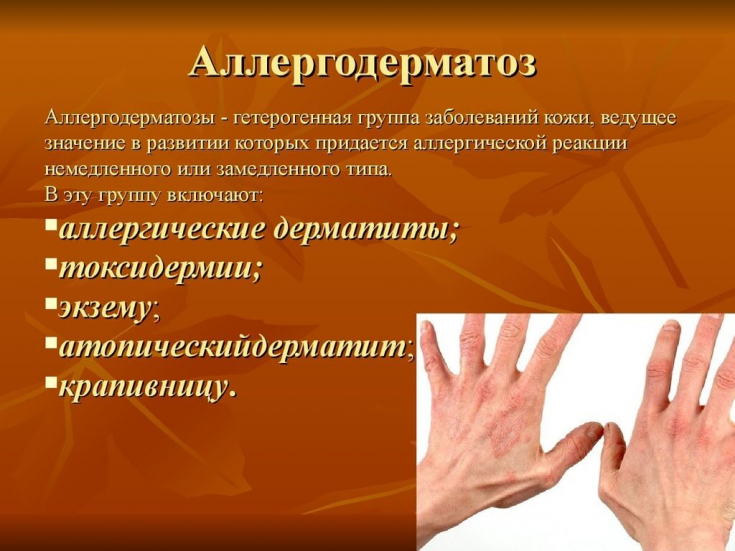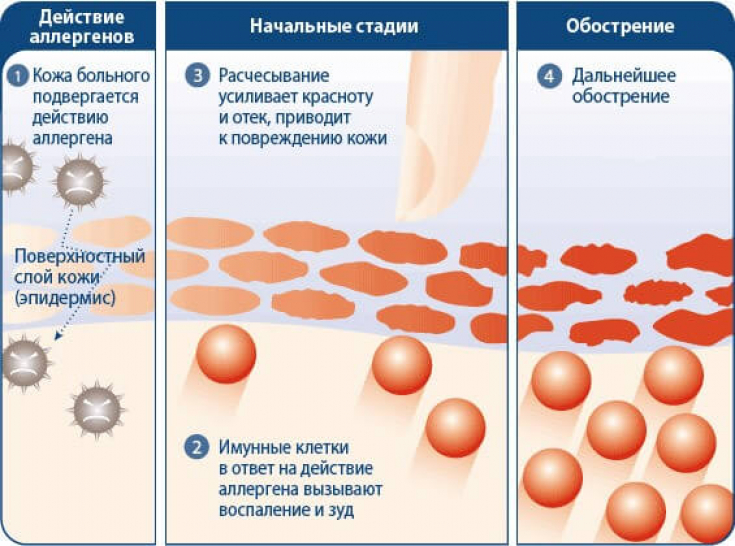The main fundamental therapy of any allergodermatosis are:
- complexity;
- individual approach;
- accounting for the main pathogenetic links of the disease;
- analysis of the features of its clinical manifestations.
Alergodermatoses (including allergic dermatitis), even if they begin acutely, often acquire chronic course, and, therefore, need not only treatment during the period of exacerbation, but also constant monitoring of the course of the disease to prevent relapses and prolong remission.
Find out in the article on estet-portal.com about the main approaches to the treatment of allergic dermatitis in practice of a dermatologist.
- Non-specific treatment of allergic dermatitis
- Systemic therapy for allergic dermatitis
- External treatment of allergic dermatitisa
Non-specific treatment of allergic dermatitis
Complex treatment of allergic dermatoses involves not only the elimination of allergenic and non-allergenic triggers, drug systemic and external therapy, but also adherence to the daily regimen and diet.
Follow us on Instagram!
Data Event includes:
- exclusion from the diet of allergens and histamine liberators;
- elimination of concomitant pathology (allergic rhinitis, bronchial asthma, allergic gastritis and enteritis, non-allergic pathology of the gastrointestinal tract, pathology of the nervous system, etc.);
- physiotherapy;
- phototherapy;
- spa treatment;
- cosmetic skin care;
- sanitary and hygienic measures at the place of residence and work.
Treatment of allergic dermatosis (including allergic dermatitis) should be started not with medical measures, but with education of the patient and his relatives.
To do this, in medical institutions of pediatric, allergological and dermatological profile, it is necessary to create appropriate schools for patients, where specialists will consult, provide recommendations on the daily routine, the formation of "correct" hypoallergenic conditions at home and at work (study), dietary habits.
A very important step in the treatment of allergic dermatitis is the consultation of psychologists and the corresponding psychotherapeutic treatment, which will significantly improve the quality of life of the sickх.

Systemic therapy for allergic dermatitis
Systemic therapy of allergic dermatoses involves the use of:
- antihistamines (I-III generations);
- membrane stabilizing agents;
- non-specific hyposensitizing therapy (sodium thiosulfate, calcium chloride, calcium gluconate);
- vitamins;
- drugs that affect the nervous system (sedatives, and sometimes tranquilizers, antipsychotics, antidepressants);
- means that normalize the functioning of the gastrointestinal tract (hepatoprotectors, pancreatic enzymes, anthelmintics, etc.).
Modern view of epidermolysis bullosa
Given systematic disorders of microbiocenosis (changes in the skin microflora in patients with allergic dermatosis, not only in the affected areas, but also on visually healthy skin, as well as intestinal dysbacteriosis), a special place in the treatment of the disease among groups of drugs that affect on the work of the gastrointestinal tract, take probiotics.
The use of antioxidants, neuroprotective agents, nootropic drugs in the systemic therapy of patients with chronic allergic dermatoses is also promising.

It is believed that the following drugs should also play an important role in the treatment of chronic allergic diseases:
- capillary stabilizing;
- antihypoxic;
- antiplatelet;
- hypolipidemic;
- general strengthening.
When there is an indication (for example, with a simultaneous secondary or primary infectious process), it becomes necessary to prescribe antibacterial or antifungal agents.
In addition, for various disorders of the immune system, it is possible to use (under strict indications) immunomodulatory or immunosuppressive drugs (for example, cyclosporinea A).
In cases of severe allergic dermatitis, systemic corticosteroids are added to therapy.
External treatment of allergic dermatitis
At the same time, external therapy should be aimed at eliminating skin inflammation and associated objective and subjective clinical manifestations of the disease, restoring the barrier functions of the skin − regression of dry skin.
In the external treatment of allergic dermatosis in general and allergic dermatitis in particular, a wide arsenal of various means is used:
- GKS;
- selective calcineurin inhibitors;
- topical antihistamines;
- emollients;
- keratolytic;
- keratoplastic;
- epithelizing agents.
How to recognize microbial eczema
In conditions of accession of infectious factor, antibacterial, antifungal, antiseptic topical preparations are also prescribed.
During an exacerbation of any allergic dermatosis, topical corticosteroids are the external therapy of choice, but they have a huge range of adverse side effects.
That is why after regression of acute inflammatory phenomena, one should switch to the use of selective inhibitors of inflammatory cytokines, emollients, herbal remedies.
Selective inhibitors of inflammatory cytokines, emollients, phytopreparations, unlike corticosteroids, can be used for a long time, because they qualitatively provide further regression of rashes, itching, dry skin, restoration of its barrier functions.
Revolution in the field of injectable cosmetology







Add a comment